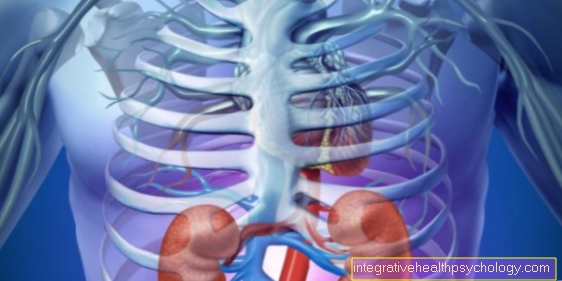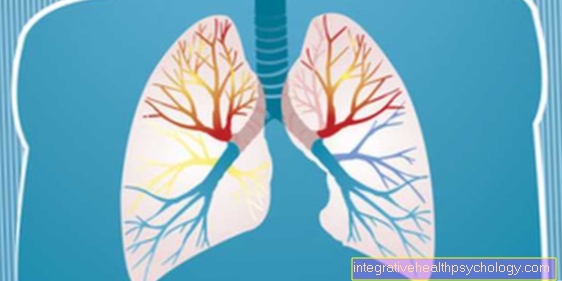Throat fistula
definition
A cervical fistula is a tube-like connecting duct between the inner throat and a punctiform opening in the neck. There are lateral (lateral) or medial (front) cervical fistulas, a distinction being made between primary and secondary fistulas.
Neck fistulas belong to the group of primary fistulas, that is, they are congenital and arise from congenital malformations in the embryonic development.

causes
Neck fistulas are congenital malformations caused by regression disorders during the development of the neck viscera in the womb. During embryonic development, a duct forms in the neck area, which normally closes again at a later point in development. In some cases this duct persists and a neck fistula develops from it.
The fistula duct is covered with covering tissue (epithelium) that produces mucus and fluid.
The mucus collects in the fistula and a fluid-filled cavity (cyst) is created. This cyst is clearly palpable as a noticeable swelling in the neck area. The accumulated fluid may occasionally drain out through an opening in the skin.
Read more about this at:
- Cervical cyst
- Fistulous duct
diagnosis
Doctors recognize a throat fistula through a visual diagnosis and a physical exam that involves palpating the throat. The fistula becomes noticeable as a well palpable bulging swelling under the skin in the neck area. In addition, the fistula is movable, which means that it can be moved by swallowing.
Read more on the topic: Swelling on the side of the neck
Imaging methods such as ultrasound (sonography) are used to confirm the diagnosis. The neck fistula is recognizable as a sharply delimited mass (tissue increase). In unclear cases, magnetic resonance imaging (MRI) can also be performed for better representation.
Concomitant symptoms
A throat fistula is noticeable as a painless swelling or thickening on the neck, otherwise those affected usually have no symptoms.
If the fistula becomes infected, there will be severe swelling in the throat area and difficulty swallowing.
The inflamed tissue becomes red and eczema can develop on the skin.If the inflammation spreads, the body reacts with a fever.
At this point at the latest, a doctor should be consulted.
The inflamed neck fistula is painful and can harden and form an abscess (encapsulated purulent collection) under the skin. Occasionally the neck fistula becomes wet and fluid or pus drains through a small opening in the skin.
Read more on this topic at: Abscess on the neck
Inflammation of a throat fistula
Neck fistulas can enlarge and become inflamed. Inflammation is caused by pathogens that penetrate the neck fistula and multiply there.
Typical signs of inflammation are swelling, reddened skin and sometimes severe pain.
Dead immune cells and bacteria form pus, which can collect in an encapsulated cavity and thus form an abscess (see: Abscess on the neck). If the patient is not treated with antibiotics in a timely manner, the infection can spread to surrounding tissue.
Important vessels that lead to the brain and heart run in the neck area. This allows the bacteria to spread throughout the body and blood poisoning (sepsis) with a high fever can occur. It is therefore important to surgically remove the neck fistula at an early stage so that it does not become infected in the first place.
You can find more information on this topic here: Neck abscess - it's so dangerous!
Treatment of a throat fistula
Neck fistulas do not resolve on their own or only very rarely, so in most cases they are surgically removed. A neck fistula is operated on even if the patient is symptom-free and the fistula has not yet become inflamed, as fistulas carry a high risk of inflammation.
An infected throat fistula is treated with antibiotics so that the inflammation can quickly subside and not spread throughout the body. Surgical removal of the fistula is only possible if there is no inflammation.
Surgery for a neck fistula
After the diagnosis and detailed examination of the neck fistula using ultrasound or MRI, the surgical removal takes place. This is a routine procedure that usually proceeds without complications.
The operation is performed under local or general anesthesia. The fistula and the opening to the surface of the skin are cut out through a small incision in the skin. Sometimes it takes several small incisions to completely remove the neck fistula.
The operation can be a complex procedure, since the opening of the fistula along with the fistula duct must be removed to the end. If the fistula is not completely removed, there is a high risk of relapse.
Should you remove a neck fistula?
A throat fistula does not in itself cause any symptoms. However, as soon as microorganisms penetrate the fistula, inflammation can lead to complications such as fever or even blood poisoning.
Therefore, at the first signs of an inflamed throat fistula, a doctor must be consulted immediately. The doctor will prescribe antibiotics, which will quickly heal the inflammation.
It becomes problematic, however, if the neck fistula becomes inflamed several times, as more and more adhesions form, which make the surgical removal of the entire fistula very difficult. Therefore, it is best to remove the fistula early, before it can even become infected.
Prognosis of a neck fistula
Fistulas on the neck get bigger and bigger over time and can become infected again and again. Very rarely neck fistulas can also degenerate, i.e. malignant tumors form from the fistulas.
Neck fistulas do not usually heal spontaneously, but in most cases have to be removed surgically.
An operation to remove the neck fistula usually goes very well and the fistula, including its ducts and branches, can be removed completely.
Sometimes recurrences (relapses) occur and an operated fistula forms again. This happens if the fistula was not completely removed during the operation.



























.jpg)
